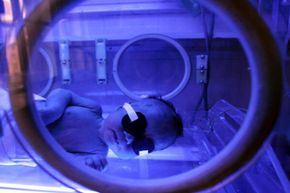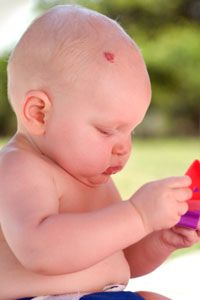If you've ever been in the neonatal unit of a hospital, you may have seen babies wearing tiny eye shields under blue lights. It almost looks like the babies are in some kind of weird blue tanning bed. Those blue beams are called bili lights, and they help prevent newborns from getting brain damage or other complications from a condition known as newborn jaundice.
Newborn jaundice, or hyperbilirubinemia, occurs when a newborn's liver isn't quite up to the task of breaking down red blood cells for excretion. The resulting buildup of the byproduct bilirubin in the body's tissues turns the infant's eyes and skin yellowish. Left untreated, the condition can lead to cerebral palsy, brain damage or hearing loss. Some amount of jaundice is expected in newborns, since the infant's liver has to take over the job of breaking down bilirubin for the first time -- the placenta and the mother's liver do the work before birth. If the jaundice lasts too long, is accompanied by other factors, or if the baby has risk factors such as being born prematurely, then treatment is necessary [source: National Institutes of Health].
Advertisement
Bili lights are a form of phototherapy. The lights -- which can be fluorescent or LED -- produce light between 420 and 470 nanometer wavelengths [source: Rice University]. (This is where the blue color comes from.) The light passes through the infant's skin and breaks down the bilirubin into a form that the baby can eliminate. It's important for the light to make contact with as much of the infant's skin as possible, so infants undergoing this treatment aren't wrapped in blankets, and nurses turn the infants regularly to expose different areas of the body.
Throughout the treatment, hospital staff monitors the infant's temperature and other vital signs. They also keep tabs on bilirubin levels via blood tests. The most common risk associated with bili light therapy is dehydration, so babies sometimes get fluids intravenously. The eye shields simply protect the infant's eyes from irritation due to the bright lights.
Treatment with bili lights usually takes 24 to 48 hours to complete, at which point the newborn's liver can handle the bilirubin itself. If the bili lights don't work, a blood exchange transfusion can be used, in which the infant's blood is slowly drained and replaced with donor blood or plasma.
Bili lights aren't usually used to treat jaundice in adults. In newborns, jaundice is typically a temporary condition, so the bili lights just need to do their job until the infant's liver functions kick in. In adults, jaundice is caused by some underlying condition, usually a liver problem or a blocked duct. Therefore, treating adult jaundice requires diagnosing and treating the root cause.
For more information on newborns and blood conditions, see the links on the next page.
Advertisement

